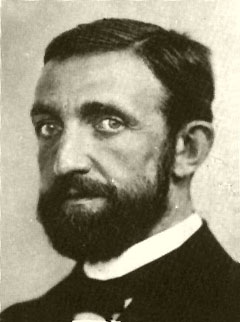| Philipp Lenard  AKA Philipp Eduard Anton Lenard AKA Philipp Eduard Anton Lenard
Born: 7-Jun-1862
Birthplace: Pozsony, Slovak Republic
Died: 20-May-1947
Location of death: Messelhausen, Germany
Cause of death: unspecified
Gender: Male
Religion: Christian
Race or Ethnicity: White
Sexual orientation: Straight
Occupation: Physicist Nationality: Germany
Executive summary: Investigations of cathode rays German physicist Philipp Lenard studied under Robert Wilhelm Bunsen and Hermann von Helmholtz, and won the Nobel Prize in Physics in 1905 for his investigations of cathode rays (electron beams). His work showed that electrons could be induced to radiate beyond the evacuated tube where they were produced, and that this radiation could travel short distances and penetrate sheets of metallic foil. From this he extrapolated a new but incorrect model of the atom, which was debated briefly until the acceptance of Ernest Rutherford's view of atomic design.
He is almost as well-known for his study of the photoelectric effect, a phenomenon which occurs when light strikes metallic surfaces. He also studied the size and shape of raindrops, describing what is sometimes called the Lenard effect, the separation of electric charges as water drops break up. His other work concerned phosphorescence, luminescence, and electrical conductivity of flames.
Lenard broke with the mainstream of science in the 1920s, disputing Albert Einstein's theory of relativity, and wrote the four-volume physics text Deutsche Physik (German Physics), which almost completely ignored "Jewish science" (i.e., Einstein). He was a strong believer in eugenics and an enthusiastic supporter of the Nazi Party as it took power in Germany, and in return the Third Reich honored him by expanding his University of Heidelberg laboratory into the Philipp Lenard Institute. He complained that he had been denied his proper credit for Wilhelm Conrad Röntgen's discovery of x-rays, and accused Einstein of misleading people with "pseudoscience" that had little experimental support. Father: (wine merchant)
Wife: Katharina Schlehner
High School: Modern College at Pressburg, Pozsony, Slovak Republic
University: University of Budapest (attended)
University: University of Vienna (attended)
University: University of Berlin (attended)
University: PhD, University of Heidelberg (1886)
Scholar: University of Heidelberg (1886-89)
Teacher: University of Bonn (1893-94)
Teacher: University of Breslau (1894-95)
Teacher: University of Aachen (1895-96)
Teacher: University of Heidelberg (1896-98)
Professor: Experimental Physics, University of Kiel (1898-1907)
Professor: Physics, University of Heidelberg (1907-31)
Administrator: Philipp Lenard Institute, University of Heidelberg (1907-31)
Rumford Medal 1896 (with Wilhelm Conrad Röntgen)
Matteucci Medal 1896 (with Wilhelm Conrad Röntgen)
Benjamin Franklin Medal 1905 (by the Franklin Institute)
Nobel Prize for Physics 1905
National Socialist German Workers Party
Royal Swedish Academy of Sciences 1905
Hungarian Academy of Sciences 1907
German Ancestry
Hungarian Ancestry
Slovak Ancestry
Author of books:
Über Kathodenstrahlen (On Cathode Rays) (1906, physics)
Ueber Aether und Materie(About Ether and Matter) (1911, physics)
Probleme komplexer Moleküle (Problems of Complex Molecules) (1914, physics)
Über das Relativitätsprinzip (On the Principle of Relativity) (1918, physics)
Grosse Naturforscher (Greater Science) (1929, memoir)
Great Men of Science: A History of Scientific Progress (1933, non-fiction)
Deutsche Physik (German Physics) (1936-37, physics, 4 vols.)
Requires Flash 7+ and Javascript.
Do you know something we don't?
Submit a correction or make a comment about this profile
Copyright ©2019 Soylent Communications
|